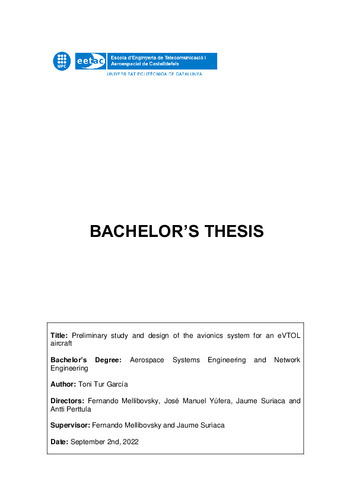Preliminary study and design of the avionics system for an eVTOL aircraft.

Visualitza/Obre
Estadístiques de LA Referencia / Recolecta
Inclou dades d'ús des de 2022
Cita com:
hdl:2117/373258
Correu electrònic de l'autortoniturgarcia99 gmail.com
gmail.com
Tutor / directorMellibovsky Elstein, Fernando

 ; Yúfera Gomez, José Manuel
; Yúfera Gomez, José Manuel

 ; Suriaca Álvarez, Jaume; Pertulla, Antti
; Suriaca Álvarez, Jaume; Pertulla, Antti
Tipus de documentTreball Final de Grau
Data2022-09-09
Condicions d'accésAccés obert
Tots els drets reservats. Aquesta obra està protegida pels drets de propietat intel·lectual i
industrial corresponents. Sense perjudici de les exempcions legals existents, queda prohibida la seva
reproducció, distribució, comunicació pública o transformació sense l'autorització del titular dels drets
Abstract
The project consists of the study, creation, implementation, and development of the avionics system of an electric Vertical Take-Off and Landing (eVTOL) airplane for an ongoing project from the company ONAEROSPACE. The plane is intended to be for 7 passengers and 1 pilot, with a maximum range of 1000+ km. The fuselage will be formed of carbon fiber composite to reduce weight and it will use electric motors powered by batteries. The avionics system will provide the aircraft with communication and navigation systems, an autonomous Take-Off (T/O) and landing system, as well as the development of cockpit management systems. This document is divided into two parts. The first part begins with the study of all the necessary tools for communication and navigation systems. That means all compulsory antennas and sensors to obtain information about the surroundings (weather, obstacles, other planes¿). The intern communication network to send data from these sensors and antennas to main flight management systems is also studied in this first part. The second part of the project is dedicated to cabin cockpit systems and the study for the future development of autonomous systems. The cabin will have a full-glass cockpit, with touchable screens and an intelligent voice assistant. It will be very ergonomic and simple, with a lot of space in the cabin. In order to have an idea of the cost of the implementation of all the systems for the aircraft, a weight and cost estimation analysis are done at the end of each section. The last part of the project consists of the study of the design of a virtual intelligent voice assistant and the implementation of autonomous systems. Nowadays, the virtual intelligent voice assistant is an artificial intelligence system that works as a pilot monitoring system which assists the pilot in order to decrease the pilot¿s workload. The future idea is that the pilot could tell commands to the voice assistant and do nothing with the hands, just control that everything works correctly. Regarding the autonomous system, the conclusion is that with the existent technology is not possible today. Nevertheless, in the future, when fully autonomous aircraft are possible, the idea is that although being fully autonomous, the pilot can take the control of the aircraft at any moment.
TitulacióGRAU EN ENGINYERIA DE SISTEMES AEROESPACIALS/GRAU EN ENGINYERIA TELEMÀTICA (Pla 2015)
Mobilitat outgoing
Mobilitat outgoing
| Fitxers | Descripció | Mida | Format | Visualitza |
|---|---|---|---|---|
| memoria.pdf | 3,991Mb | Visualitza/Obre |

